BMP4002 - Business Organizations: Legal Options for IOM Solutions
VerifiedAdded on 2023/06/14
|9
|2579
|94
Report
AI Summary
This report analyzes suitable business organizations for IOM Solutions, a sole trader business experiencing growth. It examines various legal structures available in the UK, including sole proprietorships, general partnerships, limited liability partnerships, and limited liability companies, detailing their advantages, disadvantages, liabilities, and dissolution processes. The report also covers relevant business laws in the UK, such as the Companies Act of 2006 and the Insolvency Act of 1986, and discusses concepts like negligence, vicarious liability, and individual employment rights. Ultimately, the report recommends a general partnership as the most suitable structure for IOM Solutions due to its financial stability, leadership diversity, and ease of transition to other structures. The report concludes by emphasizing the importance of considering factors like taxation, profit distribution, and liability when choosing a business organization.
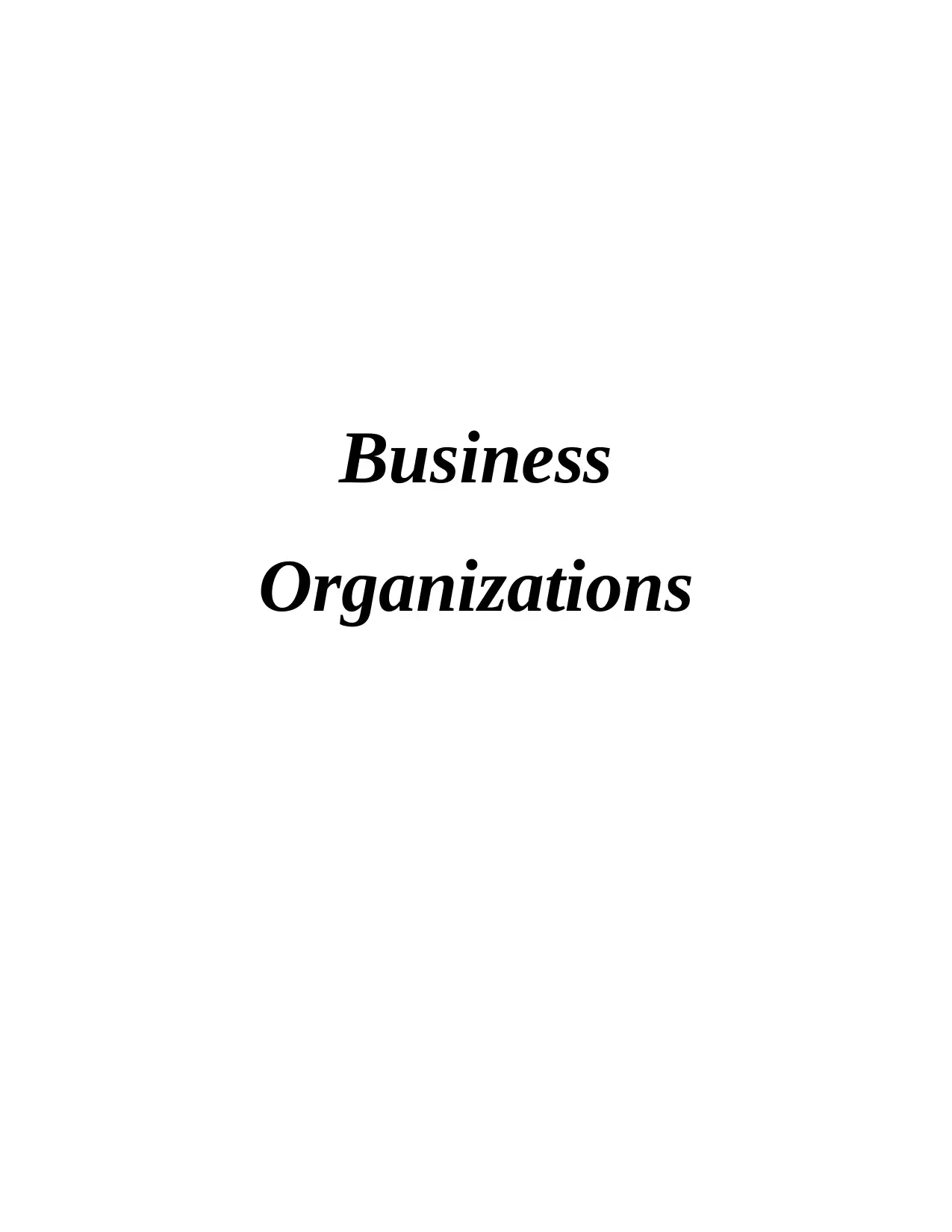
Business
Organizations
Organizations
Paraphrase This Document
Need a fresh take? Get an instant paraphrase of this document with our AI Paraphraser
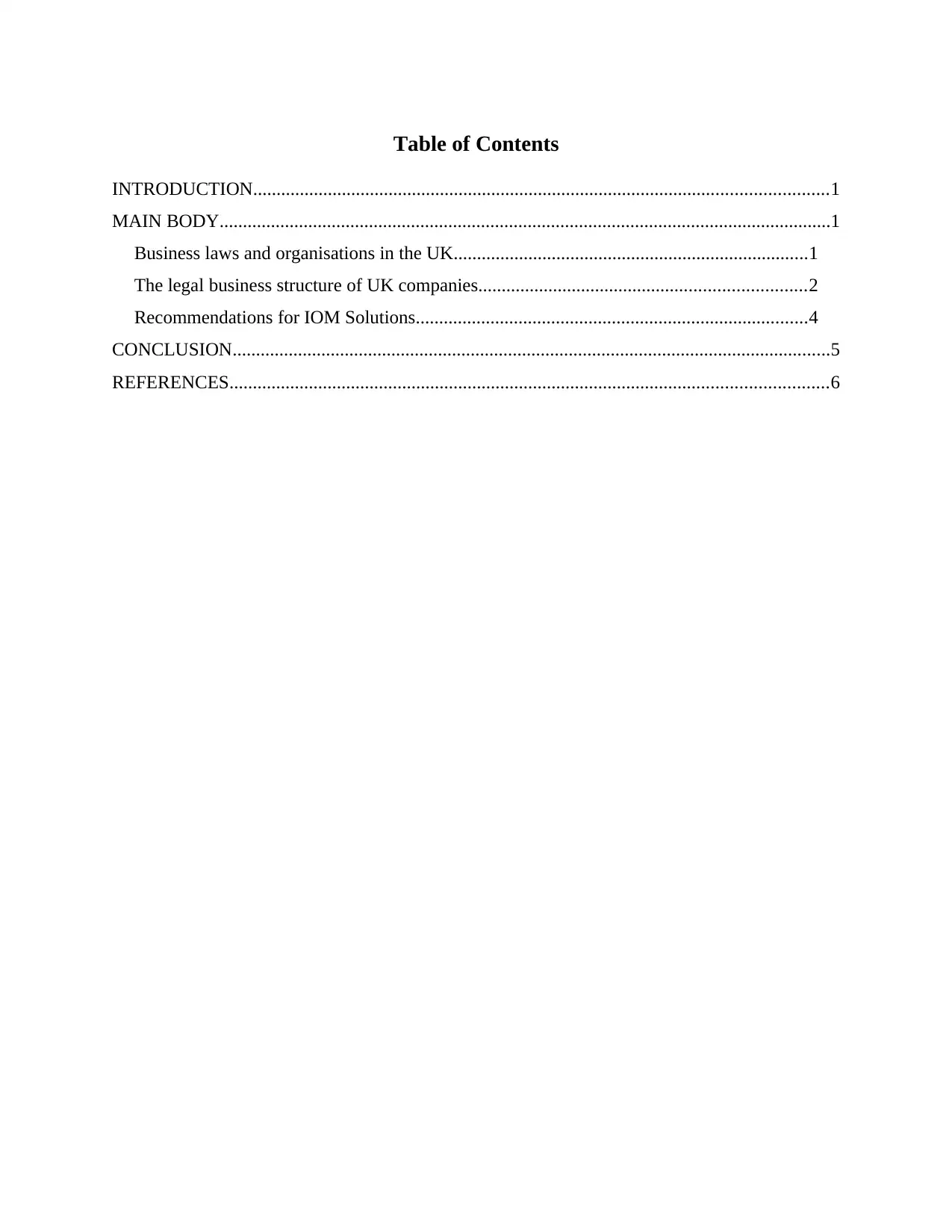
Table of Contents
INTRODUCTION...........................................................................................................................1
MAIN BODY...................................................................................................................................1
Business laws and organisations in the UK............................................................................1
The legal business structure of UK companies......................................................................2
Recommendations for IOM Solutions....................................................................................4
CONCLUSION................................................................................................................................5
REFERENCES................................................................................................................................6
INTRODUCTION...........................................................................................................................1
MAIN BODY...................................................................................................................................1
Business laws and organisations in the UK............................................................................1
The legal business structure of UK companies......................................................................2
Recommendations for IOM Solutions....................................................................................4
CONCLUSION................................................................................................................................5
REFERENCES................................................................................................................................6
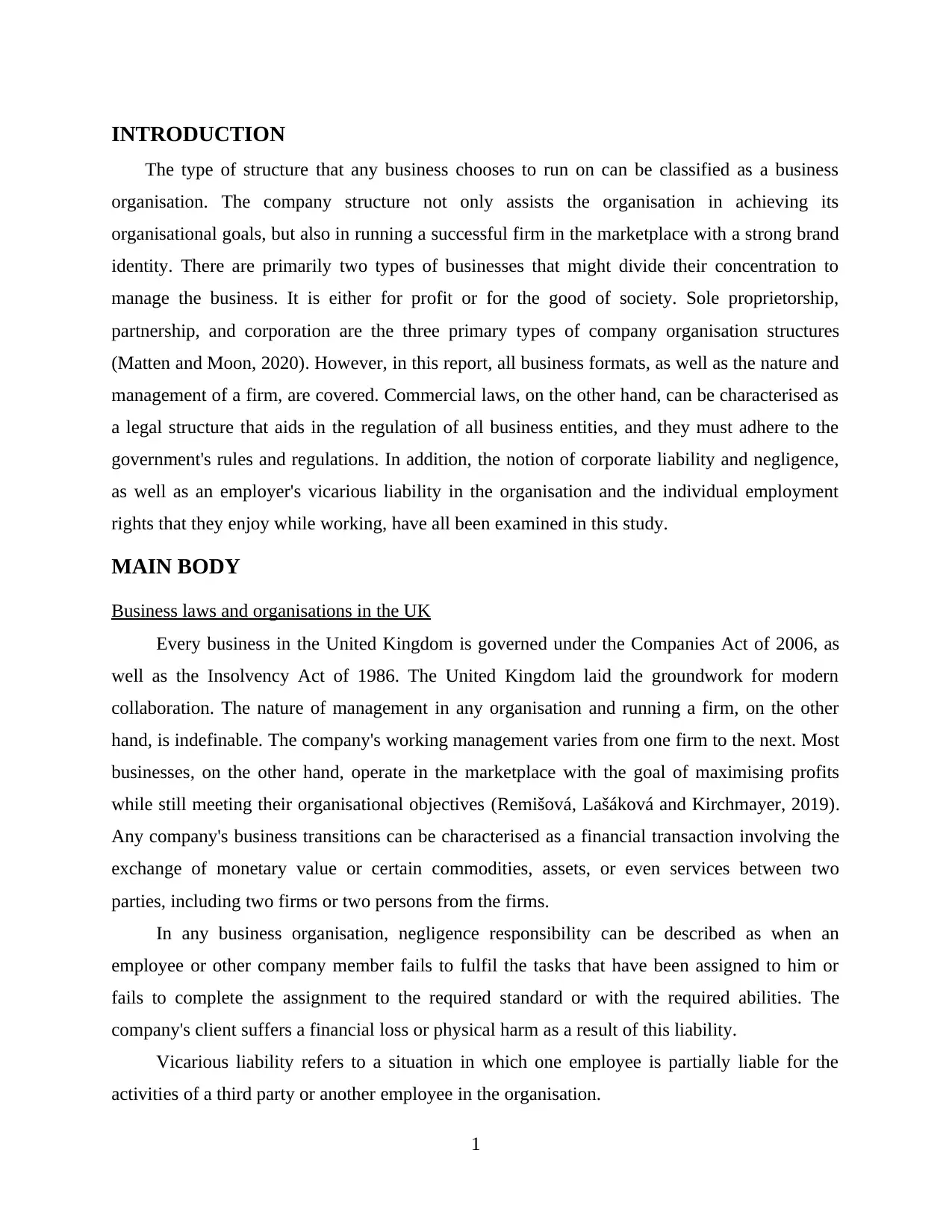
INTRODUCTION
The type of structure that any business chooses to run on can be classified as a business
organisation. The company structure not only assists the organisation in achieving its
organisational goals, but also in running a successful firm in the marketplace with a strong brand
identity. There are primarily two types of businesses that might divide their concentration to
manage the business. It is either for profit or for the good of society. Sole proprietorship,
partnership, and corporation are the three primary types of company organisation structures
(Matten and Moon, 2020). However, in this report, all business formats, as well as the nature and
management of a firm, are covered. Commercial laws, on the other hand, can be characterised as
a legal structure that aids in the regulation of all business entities, and they must adhere to the
government's rules and regulations. In addition, the notion of corporate liability and negligence,
as well as an employer's vicarious liability in the organisation and the individual employment
rights that they enjoy while working, have all been examined in this study.
MAIN BODY
Business laws and organisations in the UK
Every business in the United Kingdom is governed under the Companies Act of 2006, as
well as the Insolvency Act of 1986. The United Kingdom laid the groundwork for modern
collaboration. The nature of management in any organisation and running a firm, on the other
hand, is indefinable. The company's working management varies from one firm to the next. Most
businesses, on the other hand, operate in the marketplace with the goal of maximising profits
while still meeting their organisational objectives (Remišová, Lašáková and Kirchmayer, 2019).
Any company's business transitions can be characterised as a financial transaction involving the
exchange of monetary value or certain commodities, assets, or even services between two
parties, including two firms or two persons from the firms.
In any business organisation, negligence responsibility can be described as when an
employee or other company member fails to fulfil the tasks that have been assigned to him or
fails to complete the assignment to the required standard or with the required abilities. The
company's client suffers a financial loss or physical harm as a result of this liability.
Vicarious liability refers to a situation in which one employee is partially liable for the
activities of a third party or another employee in the organisation.
1
The type of structure that any business chooses to run on can be classified as a business
organisation. The company structure not only assists the organisation in achieving its
organisational goals, but also in running a successful firm in the marketplace with a strong brand
identity. There are primarily two types of businesses that might divide their concentration to
manage the business. It is either for profit or for the good of society. Sole proprietorship,
partnership, and corporation are the three primary types of company organisation structures
(Matten and Moon, 2020). However, in this report, all business formats, as well as the nature and
management of a firm, are covered. Commercial laws, on the other hand, can be characterised as
a legal structure that aids in the regulation of all business entities, and they must adhere to the
government's rules and regulations. In addition, the notion of corporate liability and negligence,
as well as an employer's vicarious liability in the organisation and the individual employment
rights that they enjoy while working, have all been examined in this study.
MAIN BODY
Business laws and organisations in the UK
Every business in the United Kingdom is governed under the Companies Act of 2006, as
well as the Insolvency Act of 1986. The United Kingdom laid the groundwork for modern
collaboration. The nature of management in any organisation and running a firm, on the other
hand, is indefinable. The company's working management varies from one firm to the next. Most
businesses, on the other hand, operate in the marketplace with the goal of maximising profits
while still meeting their organisational objectives (Remišová, Lašáková and Kirchmayer, 2019).
Any company's business transitions can be characterised as a financial transaction involving the
exchange of monetary value or certain commodities, assets, or even services between two
parties, including two firms or two persons from the firms.
In any business organisation, negligence responsibility can be described as when an
employee or other company member fails to fulfil the tasks that have been assigned to him or
fails to complete the assignment to the required standard or with the required abilities. The
company's client suffers a financial loss or physical harm as a result of this liability.
Vicarious liability refers to a situation in which one employee is partially liable for the
activities of a third party or another employee in the organisation.
1
⊘ This is a preview!⊘
Do you want full access?
Subscribe today to unlock all pages.

Trusted by 1+ million students worldwide
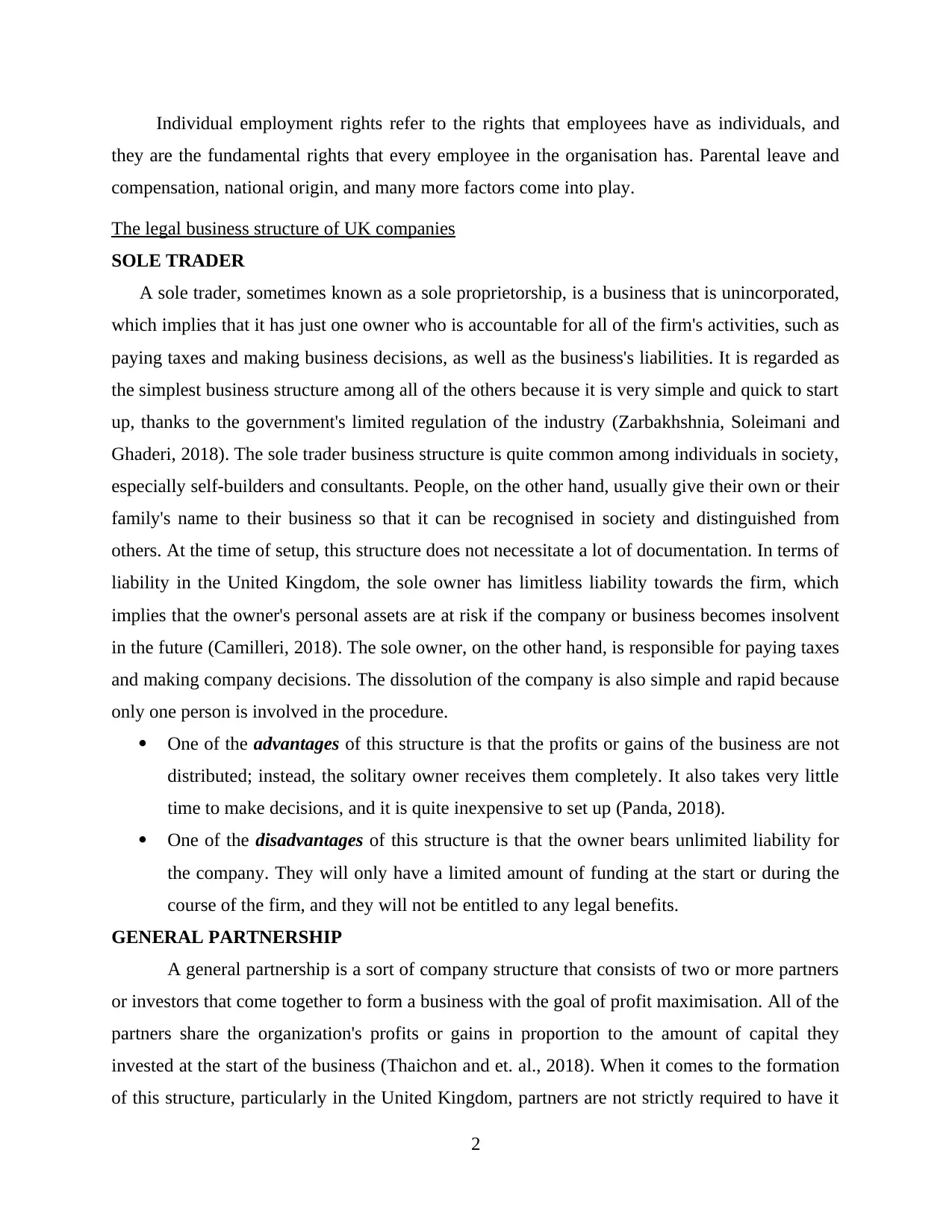
Individual employment rights refer to the rights that employees have as individuals, and
they are the fundamental rights that every employee in the organisation has. Parental leave and
compensation, national origin, and many more factors come into play.
The legal business structure of UK companies
SOLE TRADER
A sole trader, sometimes known as a sole proprietorship, is a business that is unincorporated,
which implies that it has just one owner who is accountable for all of the firm's activities, such as
paying taxes and making business decisions, as well as the business's liabilities. It is regarded as
the simplest business structure among all of the others because it is very simple and quick to start
up, thanks to the government's limited regulation of the industry (Zarbakhshnia, Soleimani and
Ghaderi, 2018). The sole trader business structure is quite common among individuals in society,
especially self-builders and consultants. People, on the other hand, usually give their own or their
family's name to their business so that it can be recognised in society and distinguished from
others. At the time of setup, this structure does not necessitate a lot of documentation. In terms of
liability in the United Kingdom, the sole owner has limitless liability towards the firm, which
implies that the owner's personal assets are at risk if the company or business becomes insolvent
in the future (Camilleri, 2018). The sole owner, on the other hand, is responsible for paying taxes
and making company decisions. The dissolution of the company is also simple and rapid because
only one person is involved in the procedure.
One of the advantages of this structure is that the profits or gains of the business are not
distributed; instead, the solitary owner receives them completely. It also takes very little
time to make decisions, and it is quite inexpensive to set up (Panda, 2018).
One of the disadvantages of this structure is that the owner bears unlimited liability for
the company. They will only have a limited amount of funding at the start or during the
course of the firm, and they will not be entitled to any legal benefits.
GENERAL PARTNERSHIP
A general partnership is a sort of company structure that consists of two or more partners
or investors that come together to form a business with the goal of profit maximisation. All of the
partners share the organization's profits or gains in proportion to the amount of capital they
invested at the start of the business (Thaichon and et. al., 2018). When it comes to the formation
of this structure, particularly in the United Kingdom, partners are not strictly required to have it
2
they are the fundamental rights that every employee in the organisation has. Parental leave and
compensation, national origin, and many more factors come into play.
The legal business structure of UK companies
SOLE TRADER
A sole trader, sometimes known as a sole proprietorship, is a business that is unincorporated,
which implies that it has just one owner who is accountable for all of the firm's activities, such as
paying taxes and making business decisions, as well as the business's liabilities. It is regarded as
the simplest business structure among all of the others because it is very simple and quick to start
up, thanks to the government's limited regulation of the industry (Zarbakhshnia, Soleimani and
Ghaderi, 2018). The sole trader business structure is quite common among individuals in society,
especially self-builders and consultants. People, on the other hand, usually give their own or their
family's name to their business so that it can be recognised in society and distinguished from
others. At the time of setup, this structure does not necessitate a lot of documentation. In terms of
liability in the United Kingdom, the sole owner has limitless liability towards the firm, which
implies that the owner's personal assets are at risk if the company or business becomes insolvent
in the future (Camilleri, 2018). The sole owner, on the other hand, is responsible for paying taxes
and making company decisions. The dissolution of the company is also simple and rapid because
only one person is involved in the procedure.
One of the advantages of this structure is that the profits or gains of the business are not
distributed; instead, the solitary owner receives them completely. It also takes very little
time to make decisions, and it is quite inexpensive to set up (Panda, 2018).
One of the disadvantages of this structure is that the owner bears unlimited liability for
the company. They will only have a limited amount of funding at the start or during the
course of the firm, and they will not be entitled to any legal benefits.
GENERAL PARTNERSHIP
A general partnership is a sort of company structure that consists of two or more partners
or investors that come together to form a business with the goal of profit maximisation. All of the
partners share the organization's profits or gains in proportion to the amount of capital they
invested at the start of the business (Thaichon and et. al., 2018). When it comes to the formation
of this structure, particularly in the United Kingdom, partners are not strictly required to have it
2
Paraphrase This Document
Need a fresh take? Get an instant paraphrase of this document with our AI Paraphraser
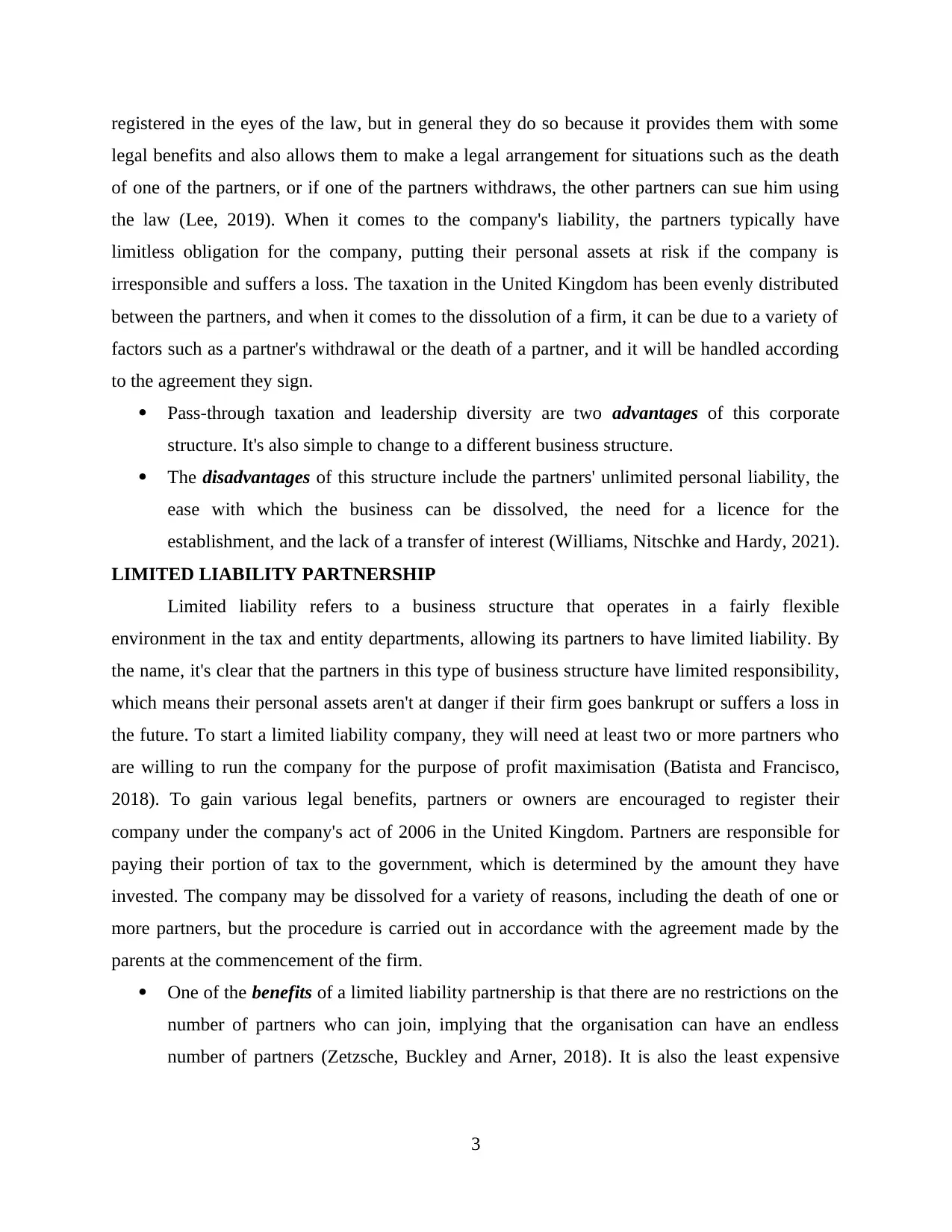
registered in the eyes of the law, but in general they do so because it provides them with some
legal benefits and also allows them to make a legal arrangement for situations such as the death
of one of the partners, or if one of the partners withdraws, the other partners can sue him using
the law (Lee, 2019). When it comes to the company's liability, the partners typically have
limitless obligation for the company, putting their personal assets at risk if the company is
irresponsible and suffers a loss. The taxation in the United Kingdom has been evenly distributed
between the partners, and when it comes to the dissolution of a firm, it can be due to a variety of
factors such as a partner's withdrawal or the death of a partner, and it will be handled according
to the agreement they sign.
Pass-through taxation and leadership diversity are two advantages of this corporate
structure. It's also simple to change to a different business structure.
The disadvantages of this structure include the partners' unlimited personal liability, the
ease with which the business can be dissolved, the need for a licence for the
establishment, and the lack of a transfer of interest (Williams, Nitschke and Hardy, 2021).
LIMITED LIABILITY PARTNERSHIP
Limited liability refers to a business structure that operates in a fairly flexible
environment in the tax and entity departments, allowing its partners to have limited liability. By
the name, it's clear that the partners in this type of business structure have limited responsibility,
which means their personal assets aren't at danger if their firm goes bankrupt or suffers a loss in
the future. To start a limited liability company, they will need at least two or more partners who
are willing to run the company for the purpose of profit maximisation (Batista and Francisco,
2018). To gain various legal benefits, partners or owners are encouraged to register their
company under the company's act of 2006 in the United Kingdom. Partners are responsible for
paying their portion of tax to the government, which is determined by the amount they have
invested. The company may be dissolved for a variety of reasons, including the death of one or
more partners, but the procedure is carried out in accordance with the agreement made by the
parents at the commencement of the firm.
One of the benefits of a limited liability partnership is that there are no restrictions on the
number of partners who can join, implying that the organisation can have an endless
number of partners (Zetzsche, Buckley and Arner, 2018). It is also the least expensive
3
legal benefits and also allows them to make a legal arrangement for situations such as the death
of one of the partners, or if one of the partners withdraws, the other partners can sue him using
the law (Lee, 2019). When it comes to the company's liability, the partners typically have
limitless obligation for the company, putting their personal assets at risk if the company is
irresponsible and suffers a loss. The taxation in the United Kingdom has been evenly distributed
between the partners, and when it comes to the dissolution of a firm, it can be due to a variety of
factors such as a partner's withdrawal or the death of a partner, and it will be handled according
to the agreement they sign.
Pass-through taxation and leadership diversity are two advantages of this corporate
structure. It's also simple to change to a different business structure.
The disadvantages of this structure include the partners' unlimited personal liability, the
ease with which the business can be dissolved, the need for a licence for the
establishment, and the lack of a transfer of interest (Williams, Nitschke and Hardy, 2021).
LIMITED LIABILITY PARTNERSHIP
Limited liability refers to a business structure that operates in a fairly flexible
environment in the tax and entity departments, allowing its partners to have limited liability. By
the name, it's clear that the partners in this type of business structure have limited responsibility,
which means their personal assets aren't at danger if their firm goes bankrupt or suffers a loss in
the future. To start a limited liability company, they will need at least two or more partners who
are willing to run the company for the purpose of profit maximisation (Batista and Francisco,
2018). To gain various legal benefits, partners or owners are encouraged to register their
company under the company's act of 2006 in the United Kingdom. Partners are responsible for
paying their portion of tax to the government, which is determined by the amount they have
invested. The company may be dissolved for a variety of reasons, including the death of one or
more partners, but the procedure is carried out in accordance with the agreement made by the
parents at the commencement of the firm.
One of the benefits of a limited liability partnership is that there are no restrictions on the
number of partners who can join, implying that the organisation can have an endless
number of partners (Zetzsche, Buckley and Arner, 2018). It is also the least expensive
3

when compared to other business forms, taking into account all of the additional benefits
that the partners receive.
The disadvantages of this structure are that the partners will be penalised for non-
compliance and will be subject to hefty income taxes.
LIMITED LIABILITY COMPANIES
A limited liability corporation is a corporate structure that protects all of its partners and
owners from limitless liability, which means that it shields its members' personal assets from
being held liable for the company's debts if the company goes bankrupt or suffers a loss in the
future. The regulation of this structure, on the other hand, differs from country to country.
Because it is a nice mix of a general partnership and a sole trader, this structure functions as a
hybrid (Orts, 2019). Profits and taxes have been divided into the partners' shareholding ratios,
based on how much they put in the company at the outset. The founding of the company
necessitated the creation of articles of incorporation. Because the process of dissolution of the
firm in this structure might be caused by a variety of factors, voting or adhering to an agreement
between the partners is recommended.
The advantages of this structure are that there are no restrictions on the number of
partners who can join the company, and the partners' liability is restricted. Employees and
partners both benefit from the management's flexibility.
The drawback of this business structure includes the high cost of formation as compared
to other options. This structure has a finite lifespan, and because to the large number of
partners in the company at the same time, ownership becomes a little complicated
(Goglio-Primard, de Saint Julien and Crespin-Mazet, 2021). Because of the same reason,
making decisions is difficult, and switching to another company structure, such as a
corporation, is extremely difficult.
Recommendations for IOM Solutions
When starting a new business or switching to a different business structure, any individual
must keep some crucial considerations and points in mind, such as the need for the firm to run
long-term while also expanding on a huge scale. When discussing all of the elements, they
discuss how the taxation amount to be paid by the partners should be divided, as well as how the
profit should be distributed. The dissolution procedure and the main factor, which is the
obligation of the partners or a single individual, are also taken into account. As a result of
4
that the partners receive.
The disadvantages of this structure are that the partners will be penalised for non-
compliance and will be subject to hefty income taxes.
LIMITED LIABILITY COMPANIES
A limited liability corporation is a corporate structure that protects all of its partners and
owners from limitless liability, which means that it shields its members' personal assets from
being held liable for the company's debts if the company goes bankrupt or suffers a loss in the
future. The regulation of this structure, on the other hand, differs from country to country.
Because it is a nice mix of a general partnership and a sole trader, this structure functions as a
hybrid (Orts, 2019). Profits and taxes have been divided into the partners' shareholding ratios,
based on how much they put in the company at the outset. The founding of the company
necessitated the creation of articles of incorporation. Because the process of dissolution of the
firm in this structure might be caused by a variety of factors, voting or adhering to an agreement
between the partners is recommended.
The advantages of this structure are that there are no restrictions on the number of
partners who can join the company, and the partners' liability is restricted. Employees and
partners both benefit from the management's flexibility.
The drawback of this business structure includes the high cost of formation as compared
to other options. This structure has a finite lifespan, and because to the large number of
partners in the company at the same time, ownership becomes a little complicated
(Goglio-Primard, de Saint Julien and Crespin-Mazet, 2021). Because of the same reason,
making decisions is difficult, and switching to another company structure, such as a
corporation, is extremely difficult.
Recommendations for IOM Solutions
When starting a new business or switching to a different business structure, any individual
must keep some crucial considerations and points in mind, such as the need for the firm to run
long-term while also expanding on a huge scale. When discussing all of the elements, they
discuss how the taxation amount to be paid by the partners should be divided, as well as how the
profit should be distributed. The dissolution procedure and the main factor, which is the
obligation of the partners or a single individual, are also taken into account. As a result of
4
⊘ This is a preview!⊘
Do you want full access?
Subscribe today to unlock all pages.

Trusted by 1+ million students worldwide
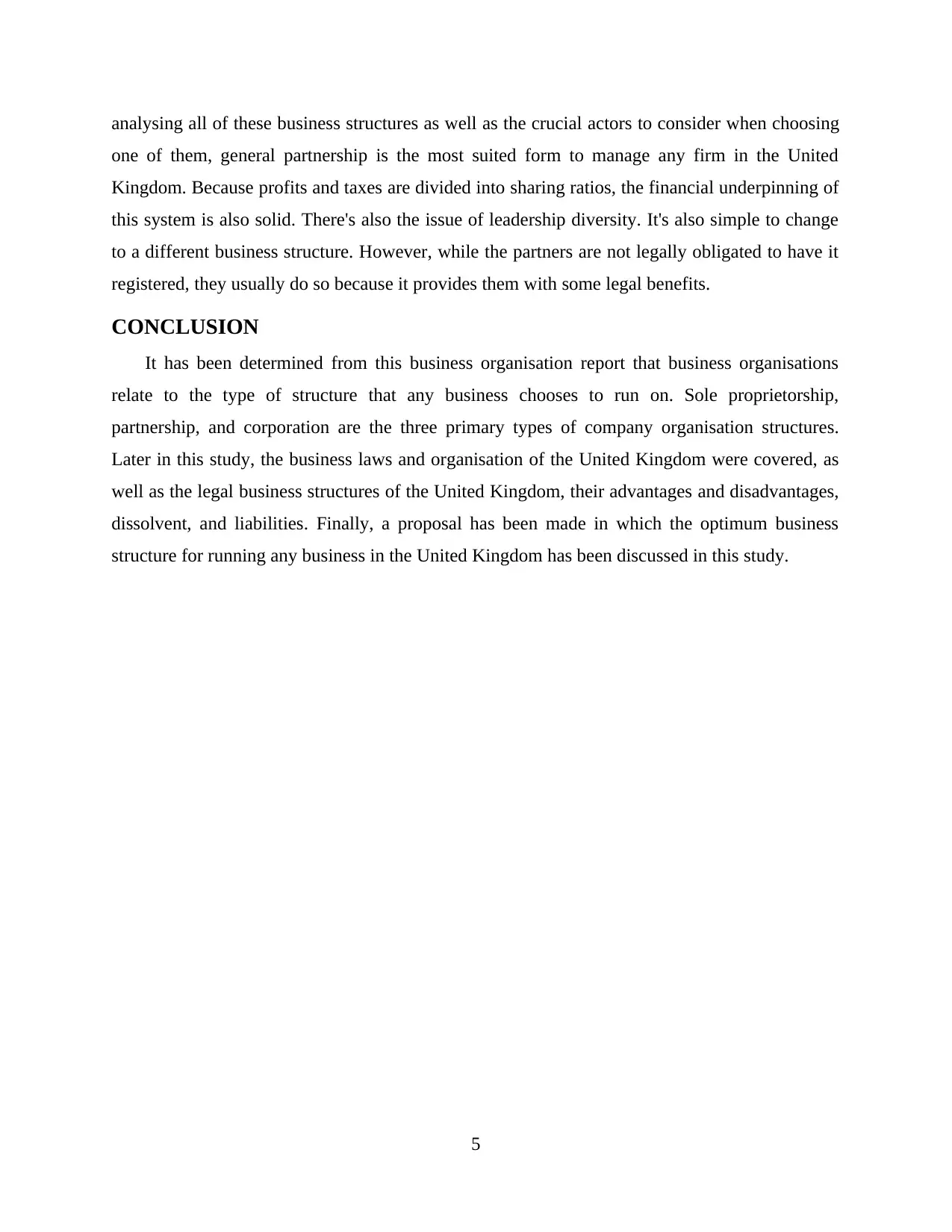
analysing all of these business structures as well as the crucial actors to consider when choosing
one of them, general partnership is the most suited form to manage any firm in the United
Kingdom. Because profits and taxes are divided into sharing ratios, the financial underpinning of
this system is also solid. There's also the issue of leadership diversity. It's also simple to change
to a different business structure. However, while the partners are not legally obligated to have it
registered, they usually do so because it provides them with some legal benefits.
CONCLUSION
It has been determined from this business organisation report that business organisations
relate to the type of structure that any business chooses to run on. Sole proprietorship,
partnership, and corporation are the three primary types of company organisation structures.
Later in this study, the business laws and organisation of the United Kingdom were covered, as
well as the legal business structures of the United Kingdom, their advantages and disadvantages,
dissolvent, and liabilities. Finally, a proposal has been made in which the optimum business
structure for running any business in the United Kingdom has been discussed in this study.
5
one of them, general partnership is the most suited form to manage any firm in the United
Kingdom. Because profits and taxes are divided into sharing ratios, the financial underpinning of
this system is also solid. There's also the issue of leadership diversity. It's also simple to change
to a different business structure. However, while the partners are not legally obligated to have it
registered, they usually do so because it provides them with some legal benefits.
CONCLUSION
It has been determined from this business organisation report that business organisations
relate to the type of structure that any business chooses to run on. Sole proprietorship,
partnership, and corporation are the three primary types of company organisation structures.
Later in this study, the business laws and organisation of the United Kingdom were covered, as
well as the legal business structures of the United Kingdom, their advantages and disadvantages,
dissolvent, and liabilities. Finally, a proposal has been made in which the optimum business
structure for running any business in the United Kingdom has been discussed in this study.
5
Paraphrase This Document
Need a fresh take? Get an instant paraphrase of this document with our AI Paraphraser
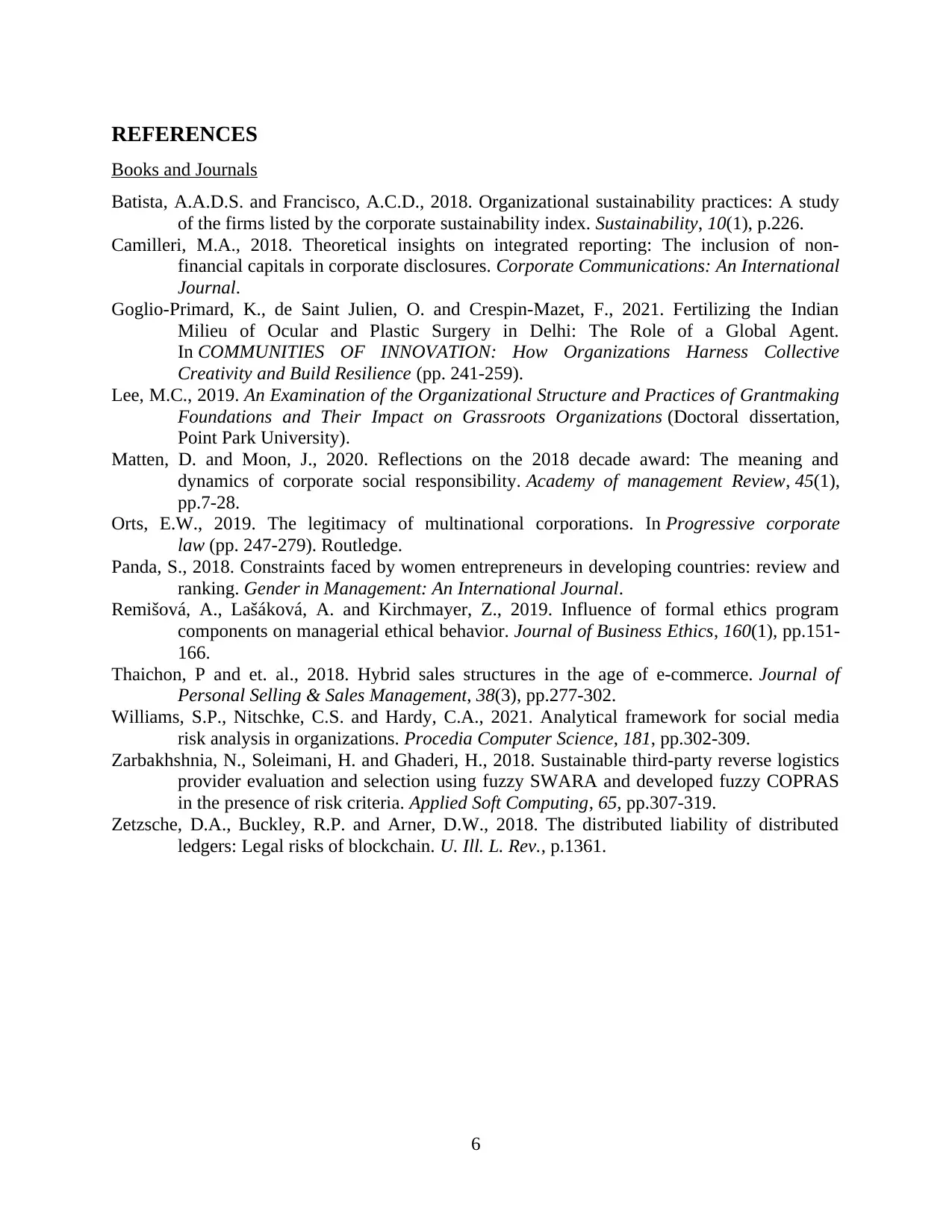
REFERENCES
Books and Journals
Batista, A.A.D.S. and Francisco, A.C.D., 2018. Organizational sustainability practices: A study
of the firms listed by the corporate sustainability index. Sustainability, 10(1), p.226.
Camilleri, M.A., 2018. Theoretical insights on integrated reporting: The inclusion of non-
financial capitals in corporate disclosures. Corporate Communications: An International
Journal.
Goglio-Primard, K., de Saint Julien, O. and Crespin-Mazet, F., 2021. Fertilizing the Indian
Milieu of Ocular and Plastic Surgery in Delhi: The Role of a Global Agent.
In COMMUNITIES OF INNOVATION: How Organizations Harness Collective
Creativity and Build Resilience (pp. 241-259).
Lee, M.C., 2019. An Examination of the Organizational Structure and Practices of Grantmaking
Foundations and Their Impact on Grassroots Organizations (Doctoral dissertation,
Point Park University).
Matten, D. and Moon, J., 2020. Reflections on the 2018 decade award: The meaning and
dynamics of corporate social responsibility. Academy of management Review, 45(1),
pp.7-28.
Orts, E.W., 2019. The legitimacy of multinational corporations. In Progressive corporate
law (pp. 247-279). Routledge.
Panda, S., 2018. Constraints faced by women entrepreneurs in developing countries: review and
ranking. Gender in Management: An International Journal.
Remišová, A., Lašáková, A. and Kirchmayer, Z., 2019. Influence of formal ethics program
components on managerial ethical behavior. Journal of Business Ethics, 160(1), pp.151-
166.
Thaichon, P and et. al., 2018. Hybrid sales structures in the age of e-commerce. Journal of
Personal Selling & Sales Management, 38(3), pp.277-302.
Williams, S.P., Nitschke, C.S. and Hardy, C.A., 2021. Analytical framework for social media
risk analysis in organizations. Procedia Computer Science, 181, pp.302-309.
Zarbakhshnia, N., Soleimani, H. and Ghaderi, H., 2018. Sustainable third-party reverse logistics
provider evaluation and selection using fuzzy SWARA and developed fuzzy COPRAS
in the presence of risk criteria. Applied Soft Computing, 65, pp.307-319.
Zetzsche, D.A., Buckley, R.P. and Arner, D.W., 2018. The distributed liability of distributed
ledgers: Legal risks of blockchain. U. Ill. L. Rev., p.1361.
6
Books and Journals
Batista, A.A.D.S. and Francisco, A.C.D., 2018. Organizational sustainability practices: A study
of the firms listed by the corporate sustainability index. Sustainability, 10(1), p.226.
Camilleri, M.A., 2018. Theoretical insights on integrated reporting: The inclusion of non-
financial capitals in corporate disclosures. Corporate Communications: An International
Journal.
Goglio-Primard, K., de Saint Julien, O. and Crespin-Mazet, F., 2021. Fertilizing the Indian
Milieu of Ocular and Plastic Surgery in Delhi: The Role of a Global Agent.
In COMMUNITIES OF INNOVATION: How Organizations Harness Collective
Creativity and Build Resilience (pp. 241-259).
Lee, M.C., 2019. An Examination of the Organizational Structure and Practices of Grantmaking
Foundations and Their Impact on Grassroots Organizations (Doctoral dissertation,
Point Park University).
Matten, D. and Moon, J., 2020. Reflections on the 2018 decade award: The meaning and
dynamics of corporate social responsibility. Academy of management Review, 45(1),
pp.7-28.
Orts, E.W., 2019. The legitimacy of multinational corporations. In Progressive corporate
law (pp. 247-279). Routledge.
Panda, S., 2018. Constraints faced by women entrepreneurs in developing countries: review and
ranking. Gender in Management: An International Journal.
Remišová, A., Lašáková, A. and Kirchmayer, Z., 2019. Influence of formal ethics program
components on managerial ethical behavior. Journal of Business Ethics, 160(1), pp.151-
166.
Thaichon, P and et. al., 2018. Hybrid sales structures in the age of e-commerce. Journal of
Personal Selling & Sales Management, 38(3), pp.277-302.
Williams, S.P., Nitschke, C.S. and Hardy, C.A., 2021. Analytical framework for social media
risk analysis in organizations. Procedia Computer Science, 181, pp.302-309.
Zarbakhshnia, N., Soleimani, H. and Ghaderi, H., 2018. Sustainable third-party reverse logistics
provider evaluation and selection using fuzzy SWARA and developed fuzzy COPRAS
in the presence of risk criteria. Applied Soft Computing, 65, pp.307-319.
Zetzsche, D.A., Buckley, R.P. and Arner, D.W., 2018. The distributed liability of distributed
ledgers: Legal risks of blockchain. U. Ill. L. Rev., p.1361.
6

7
⊘ This is a preview!⊘
Do you want full access?
Subscribe today to unlock all pages.

Trusted by 1+ million students worldwide
1 out of 9
Related Documents
Your All-in-One AI-Powered Toolkit for Academic Success.
+13062052269
info@desklib.com
Available 24*7 on WhatsApp / Email
![[object Object]](/_next/static/media/star-bottom.7253800d.svg)
Unlock your academic potential
Copyright © 2020–2025 A2Z Services. All Rights Reserved. Developed and managed by ZUCOL.


